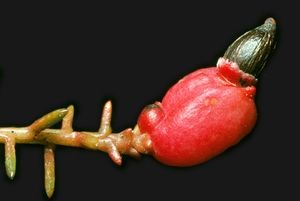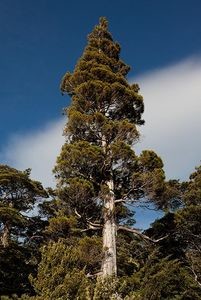 The ‘naked seed’ of pygmy pine (Lepidothamnus laxifolius). Photo: John Braggins.Conifers are cone-bearing, woody seed plants. They belong an ancient group of plants called the gymnosperms. This group appeared approximately 360 million years ago (before flowering plants) and produce seeds that are not enclosed within plant tissue. The name gymnosperm comes from the Greek gymnos ‘nudity’ and sperm ‘seed’ and translates as ‘naked seed’.
The ‘naked seed’ of pygmy pine (Lepidothamnus laxifolius). Photo: John Braggins.Conifers are cone-bearing, woody seed plants. They belong an ancient group of plants called the gymnosperms. This group appeared approximately 360 million years ago (before flowering plants) and produce seeds that are not enclosed within plant tissue. The name gymnosperm comes from the Greek gymnos ‘nudity’ and sperm ‘seed’ and translates as ‘naked seed’.
In New Zealand conifers dominate rainforests and some infertile shrublands. This contrasts with the rest of the temperate and tropical forests of the world where conifers have been superseded by flowering plants.
 Pahautea (Libocedrus bidwillii). Photo: Mike Thorsen.The native conifers of New Zealand are all endemic, meaning they are not found anywhere else in the world. There are 18 native conifers in New Zealand and these belong to four families:
Pahautea (Libocedrus bidwillii). Photo: Mike Thorsen.The native conifers of New Zealand are all endemic, meaning they are not found anywhere else in the world. There are 18 native conifers in New Zealand and these belong to four families:
- Podocarpaceae (podocarp family) - 15 native species and two exotic species
- Araucariaceae (araucarian family) - one native New Zealand species - the kauri (Agathis australis) and two exotic species
- Phyllocladaceae (celery pine family) - three native species in New Zealand and none exotic
- Cupressaceae (cypress family) - two native species in New Zealand and ten exotic one
Conifers are often referred to as softwoods as opposed to the flowering trees that are hardwoods. Most flowering trees do have harder wood than conifers but there are some exceptions.
For more information see:
